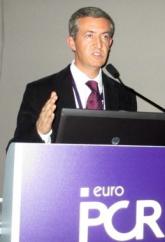News

DESolve Bioresorbable stent speeds coronary healing
Major finding: Patients averaged a 0.21-mm late lumen loss 6 months after receiving a DESolve bioresorbable vascular scaffold.Data source: The...

EXPERT OPINION FROM EUROPCR 2013
PARIS – Bioresorbable coronary stents programmed to disappear look like they are here to stay.
Late last year, interventional cardiology began its slow but inexorable shift from metallic coronary stents to bioresorbable scaffolds that disappear from arteries within a couple of years, and in newer models, within several months.
The first bioresorbable coronary stent, called a bioresorbable vascular scaffold (BVS), came out for routine use in Europe last September under the brand name Absorb. While the U.S. pivotal trial for this BVS launched only in January, as early as last September interventionalists at a few European centers felt so convinced by the BVS concept that they designated it their "default" device for percutaneous coronary interventions (PCI). While early European results from more than 200 patients treated with default BVS were generally encouraging, although not without a problem, default BVS currently operates with enough exclusions and caveats to warrant a big asterisk.
A major lesson from "default" use of BVS is that they are clearly not for everyone right now. The largest default bioresorbable program reported so far includes 176 BVS placed by PCI in 174 patients during September 2012 through April 2013 at the Thoraxcenter in Rotterdam. Those 176 interventions were out of 1,018 procedures done in 958 patients during the same 8-month period. Despite having declared their default device, Thoraxcenter interventionalists decided that they needed something other than a BVS for more than 80% of their PCI patients, Dr. Robert-Jan van Geuns reported at the annual meeting of the European Association of Percutaneous Coronary Interventions.
The data so far are limited, "from small registries," not the sort of evidence that changes practice, admitted Dr. van Geuns, "but I think we are seeing where we are going" with BVS.
"With BVS, there is the hope for therapeutic benefit with possible vessel remodeling," said Dr. Stephan Windecker, professor and chief of cardiology at University Hospital in Bern, Switzerland. "I think it may have long-term benefits that we do not see" with conventional drug-eluting metallic stents. "There is strong evidence for a different way of vessel remodeling when the scaffold disappears," said Dr. Windecker, expressing the widely held but still clinically unproven view that treating patients with stents that disappear once they’ve done their job will be better for patients than are standard metal stents that stay in place forever.
Two Rotterdam BVS registries
Dr. van Geuns did not specify all the criteria his group applied for targeting BVS, aside from saying in an interview that they were younger patients with relatively few comorbidities and a life expectancy of at least 2 years so that they could potentially benefit from long-term advantages after a BVS disappears.
The Thoraxcenter’s 174 BVS-treated patients included 41 patients with a ST-elevation myocardial infarction who entered a separate review, two with prior coronary artery bypass surgery, and 131 who underwent PCI for other reasons who were the focus of Dr. van Geuns’ report. Procedural and clinical success occurred in 126 of the 131 patients (95%). The only complications during median follow-up of 137 days were two cases of stent thrombosis, one myocardial infarction in a nontarget vessel that occurred during the first 30 days after treatment, and one death. The operators generally found BVS to be deliverable, though with longer procedure times, more wires needed, and more predilatation of the PCI vessel, compared with what’s usual for placing metallic coronary stents.
The Polish ACS registry
Two other series reported at the meeting used BVS as the default device in patients with acute coronary syndrome (ACS). The POLAR ACS (Polish Absorb Registry for ACS) enrolled 88 ACS patients who received at least one BVS during November 2012-May 2013 when participating centers used BVS as their default devices for PCI. Treatment also included aspiration thrombectomy in 15 patients (17%), and predilatation of the infarct-related artery in 78 patients (89%).
The BVS intervention had 100% procedural success and produced robust, TIMI grade III flow in all of the treated patients, reported Dr. Dariusz Dudek, professor and head of interventional cardiology at Jagiellonian University in Krakow, Poland. The BVS was "easy to deliver," he said. But after predilatation and before BVS placement, one patient had no reflow and two had slow flow. Following completion of the procedure, one patient continued to have slow flow and four patients needed bail-out placement of another BVS. The only major adverse coronary event during hospitalization was need for PCI outside the target vessel.

Major finding: Patients averaged a 0.21-mm late lumen loss 6 months after receiving a DESolve bioresorbable vascular scaffold.Data source: The...
